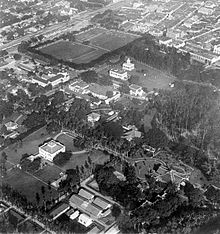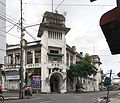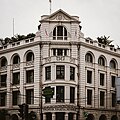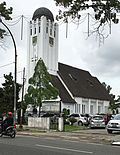List of colonial buildings in Medan: Difference between revisions
Rochelimit (talk | contribs) |
Rochelimit (talk | contribs) |
||
| Line 146: | Line 146: | ||
! style="width:120px;"|Latest image |
! style="width:120px;"|Latest image |
||
! style="width:120px;"|Oldest image |
! style="width:120px;"|Oldest image |
||
|- |
|||
|Bioskop Bali (demolished, now ) |
|||
|Oranje Bioscoop; Bioskop Bali (post-independence) |
|||
|1908<ref>http://www.acehtraffic.com/2012/10/walaupun-film-porno-ditayangkan-bioskop.html</ref> |
|||
| |
|||
|{{coord|3.589886|98.681097}} |
|||
|[[File:COLLECTIE TROPENMUSEUM Luchtfoto van Medan met onder meer het spoorwegemplacement van de DSM de Oranje Bioscoop en het Grand Hotel Medan TMnr 10015050.jpg|120px|center]] |
|||
|[[File:COLLECTIE TROPENMUSEUM Straatgezicht bij de Oranje Bioscoop en de voetgangersbrug over het spoorwegemplacement TMnr 60039320.jpg|120px|center]] |
|||
|- |
|- |
||
|Asuransi Jasindo |
|Asuransi Jasindo |
||
Revision as of 11:56, 16 March 2016

Colonial buildings in Medan include those that were constructed in Medan during the period of Dutch East Indies, now Indonesia. Dutch colonial buildings were start to be build in Medan (at that time Deli) following the establishment of the Deli Company in 1869, whose establishment set Medan from a small kampong of few hundred people in 1869 into the largest city in Sumatra and the capital of North Sumatra in 1891 when the Sultan of Deli moved his residence here.[1] The rapid development ushered the growth of western-centric development in Medan, and hence a number of western-style architecture appears in Medan.[2][3] Despite its relatively late modernization in the late 19th-century compared to older established cities like Jakarta and Makassar, Medan contains an abundant colonial architecture heritages. 42 buildings has been declared of significant historical value.[4]
Colonial architecture in Medan is dominated with Rationalist architectural style, apparent in buildings such as houses, churches, civic buildings, commercial buildings and offices. European city planning based on garden city concept were also implemented in Medan, similar to Jakarta's Menteng and the mountain city of Bandung.
Despite the abundance of Dutch colonial architecture heritage in Medan, colonial buildings are being demolished at an alarming speed. Non-governmental organizations claimed that almost 90 percent of the 42 protected buildings had either been demolished or modified, despite the provincial ruling No. 6/1988 which bans the modification of these buildings. 73 buildings had not yet been protected, one example is the Mega Eltra buildings, constructed in 1912 but has since been demolished.[4] Other heritage buildings that have been demolished are the Kerapatan building on Jl. Brig. Jen. Katamso, a bank building on Jl. Pemuda and the Public Works office on Jl. Listrik.[4]
List of buildings
Below is a list of colonial buildings found in Medan. The list is divided into the colonial architectural styles: Eclecticism (before 20th century), Dutch Rationalism and Traditionalism (1900s-1920s), and Modernism (1920s-1930s). The list is sorted alphabetically according to its official (local) name. The list can also be sorted to each category.
Buildings which undertook complete renovation which resulted in different form are listed separately to distinguish the different architectural form.
Eclecticism (before 20th century)
Some of the first colonial buildings of Medan were concentrated around the Esplanade (now Lapangan Merdeka), the city square of Medan. Many of the first buildings were of simple wooden structure, such as the hoofdkantoor van de Deli Maatschappij te Medan which during the time of its opening in 1870 was also used for church, administration building, hospital and a feast hall.[5] Popular style at the time were the neoclassicism and eclectic Romanticism.[6] Buildings from the period were low in its architectural level due to the lack of skilled architectural practice. Structural engineers are provided easily by the builder, not by the government or by a private sector.[6]
| Last official name | Former names | Year | Architect | Location | Latest image | Oldest image |
|---|---|---|---|---|---|---|
| Agentschap van de NHM (demolished in 1930, now Bank Mandiri) | Agentschap van de NHM | 1888[7] | anonymous | 3°35′20″N 98°40′41″E / 3.588925°N 98.677956°E | ||
| Dinas Kebudayaan dan Pariwisata, "Department of Culture and Tourism" | Deli vrijmetselaarsloge | 1892[8] | anonymous | 3°35′39″N 98°40′50″E / 3.594070°N 98.680533°E | ||
| Dharma Deli Hotel | Hotel De Boer[9] | 1898 (opened)[9][10] | 3°35′30″N 98°40′37″E / 3.591598°N 98.676851°E |  |
 | |
| Grand Hotel Medan (demolished, now Bank Negara Indonesia - KCP Medan Pulau Pinang)[11] | Hotel de Vink[11] | 1884[11] | 3°35′22″N 98°40′47″E / 3.589329°N 98.679815°E |  | ||
| Hoofdkantoor van de Deli Maatschappij (demolished, and replaced with larger office in 1910)[10] | Hoofdkantoor van de Deli Maatschappij | 1869-1870[10] | anonymous | 3°35′35″N 98°40′31″E / 3.592962°N 98.675214°E | ||
| Lapangan Merdeka | de Esplanade | 1880 | anonymous | |||
| Masjid Raya Al-Osmani | 1872 | 3°43′56″N 98°40′34″E / 3.732337°N 98.676074°E |  | |||
| Paleis van de Tengku Besar van Deli | Paleis van de Tengku Besar van Deli |  | ||||
| Piaggio/Vespa (revamped, only the facade persisted) | 1900s[12] | 3°35′11″N 98°40′46″E / 3.586291°N 98.679437°E | ||||
| Seng Hap (abandoned, deteriorates) | Seng Hap[13] | 1900[13] | anonymous | 3°35′19″N 98°40′43″E / 3.588479°N 98.678514°E |  | |
| Rumah Tjong A Fie, 張阿輝 故居 | Tjong A Fie Mansion | 1900s[14] |  |
 | ||
| Sociëteit De Witte (first form, demolished)[11] | Sociëteit De Witte (first form) | 1882[11] | ||||
| Standard Chartered Bank | Ambtswoning van de resident van het Oostkust van Sumatra (1898),[15] Gouverneurshuis te Medan | 1898[15] | anonymous |  |
 |
Rationalism and Traditionalism (1900s – 1920s)
New technological possibilities gradually transformed the architectural style into a modern form. Two architectural movements appeared in the Netherlands and the Netherlands East Indies: the Dutch Rationalism and Traditionalism.[16]
Dutch Rationalism was mainly inspired by the works of Berlage; the subsequent style in the tropical climate of Indonesia is known as New Indies Style.[17] The style is the result of the attempt to develop new solutions to integrate traditional precedents with new technological possibilities.
The Traditionalist movement appeared in the 1910s. It is basically the revival of the late 19th-century eclecticism, but was mainly inspired by classicism. Unlike the earlier low-quality architecture, the new traditionalist movement make use of modern materials e.g. reinforced concrete and steel frames. Facades are mostly of natural stone. The monumental character of this style is popular for offices, warehouses and garages.[16]
| Last official name | Former names | Year | Architect | Location | Latest image | Oldest image |
|---|---|---|---|---|---|---|
| Bioskop Bali (demolished, now ) | Oranje Bioscoop; Bioskop Bali (post-independence) | 1908[18] | 3°35′24″N 98°40′52″E / 3.589886°N 98.681097°E |  |
 | |
| Asuransi Jasindo | Stoormvaartmaatschappij Nederland en Rotterdamse Lloyd; Nederlands-Indische Handelsbank, NIH (until 1940) | early 20th-century | 3°35′19″N 98°40′42″E / 3.588661°N 98.678436°E | |||
| Chinese lagere school |  | |||||
| Abandoned building (2004-now)[10] | Hoofdkantoor van Deli Maatschappij, head office of the Deli Company,[5] Director's Office of PT Perkebunan IX (1959) | 1910[5] | D. Berendse[5] | 3°35′35″N 98°40′31″E / 3.592962°N 98.675214°E |  | |
| Angkatan Muda Pembaharuan Indonesia (neglected, heavily deteriorates) | Medan's Warenhuis (1919), Kantor Departemen Tenaga Kerja Tk. I Sumut | 1919[19] | G. Bos[19] | 3°35′18″N 98°40′37″E / 3.588343°N 98.676836°E |  |
|
| Bank Indonesia | De Javasche Bank[5] | 1909[5] | Hulswit en Cuypers[20] | 3°35′27″N 98°40′37″E / 3.590752°N 98.676977°E |  |
 |
| BKS PPS (Badan Kerja-sama Perusahaan Perkebunan Sumatera), "Sumatra Planters Association" (1967) | AVROS (Algemeene Vereeniging van Rubberplanters ter Oostkust van Sumatera)[21] | 1918[19] | G.H. Mulder[19] | 3°35′04″N 98°40′50″E / 3.584420°N 98.680551°E |  |
 |
| Dharma Niaga | Carl Schlieper | 1919[22] | 3°35′06″N 98°40′49″E / 3.585066°N 98.680220°E | |||
| Gedung Balai Kota Lama | Raadhuis, Gemeentehuis Medan[5] | 1908-1909[5] | Ch. M. Boon[5][23] | 3°35′25″N 98°40′38″E / 3.590380°N 98.677188°E |  |
 |
| Gereja Kristen Indonesia Sumatera Utara | Gereformeerde Kerk | 1918 | Tj. Kuipers | 3°35′02″N 98°40′18″E / 3.583877°N 98.671651°E |  | |
| Kantor Gubernur Sumatera Utara | Proefstation Deli Tabak[24] | 1913[24] | 3°34′50″N 98°40′20″E / 3.580418°N 98.672145°E | |||
| Kantor Pos Medan, "Medan Post Office" | Medan Post- en telegraafkantoor | 1909[10]-1911 | S. Snuyf (from BOW)[10] | 3°35′31″N 98°40′39″E / 3.591851°N 98.677404°E |  |
 |
| Kereta Api (Persero) Divisi Regional I Sumatera Utara | Hoofdkantoor van de Deli Spoorweg Maatschappij[8] | 1918[8] | Th. Karsten[8] | 3°35′38″N 98°40′47″E / 3.593770°N 98.679736°E |  | |
| London Sumatera | Harrison & Crossfield[13] | 1909 | 3°35′19″N 98°40′41″E / 3.588613°N 98.678080°E |  |
 | |
| Masjid Raya Medan | Grote Moskee | 1909 | Van Erp, JA Tingdeman | 3°34′30″N 98°41′14″E / 3.575111°N 98.687321°E |  |
 |
| Katedral Medan, "Medan Cathedral" | 1905 |  | ||||
| Mega Eltra | Lindeteves-Stokvis (1912); BPM (1952) | 1912 | ||||
| Telkom | Telefoondienst van de DSM[25][8] | 3°35′39″N 98°40′46″E / 3.594281°N 98.679577°E |  |
 |
Modernism (1920s-1940s)
The period saw the emergence of Modernism and its varieties, namely Art Deco, Nieuwe Bouwen, Amsterdam School and other variations. Art Deco evolved from earlier Dutch Rationalism. The form is symmetrical and exudes technological progress and glamour, with rich color and bold geometric shapes.
In the following period between late 1930s and 1940s, Art Deco evolved into a new style known as Nieuwe Bouwen (Dutch term for Modernism) or Functionalism. Instead of creating decorative style on the facade, the architect creates style in the clear arrangement of space. These Nieuwe Bouwen buildings were less symmetrical and more expressive in form, using simple universal form such as cylinder or tube, apparent in buildings such as the de Rex cinema building, now the Ria Restaurant (which was clumsily restored as Art Deco-style buildings) and the new building of the Medan railway station.
Medan also became the ground for implementation of Amsterdam School-styled buildings not found in many parts of Indonesia. The St. Elizabeth's hospital (1929) by J.M. Groenewegen and the original building of Centrale Pasar (destroyed by fire) shows influence of Amsterdam School.
| Last official name | Former names | Year | Architect | Location | Latest image | Oldest image |
|---|---|---|---|---|---|---|
| Gemeentelijke Vismarkt |  | |||||
| Stork[12] | 1920s[12] | 3°35′16″N 98°40′43″E / 3.587723°N 98.678539°E | ||||
| Asuransi Jiwasraya | NILLMIJ | 1919[19] | Thomas Karsten[19] | 3°35′03″N 98°40′48″E / 3.584277°N 98.680138°E |  |
|
| Bank BNI Kesawan | Chartered Bank of India, China and Australia[12] | 3°35′12″N 98°40′45″E / 3.586742°N 98.679050°E | ||||
| Bank Danamon Kesawan | Bank of China[12] | 1930[12] | 3°35′12″N 98°40′45″E / 3.586637°N 98.679211°E | |||
| Bank Mandiri | Nederlandsch-Indische Escompto Maatschappij[22] | 1927 | Fermont en Cuypers | 3°35′06″N 98°40′50″E / 3.584934°N 98.680689°E | ||
| Bank Mandiri | Nederlands-Indische Handelsbank (NIH)[20] | 1940[20] | C.P. Wolff Schoemaker[20] | 3°35′20″N 98°40′41″E / 3.588925°N 98.677956°E | ||
| Bank Mandiri Medan Lapangan Merdeka | de Factorij, Nederlandse Handel-Maatschappij (1929)[26] | 1929[19] | J. de Bruin (from Fermont en Ed. Cuypers)[19][20] | 3°35′22″N 98°40′40″E / 3.589581°N 98.677737°E |  |
 |
| Bata | Warenhuis Cornfield[12] | 1951[12] | H. van den Heuvel[12] | 3°35′11″N 98°40′45″E / 3.586502°N 98.679300°E | ||
| Dinas Kebudayaan dan Pariwisata, "Department of Culture and Tourism" (deteriorating as of 2016) | Boekhandel en Drukkerij Varekamp & Co. (Bookstore and Printing Varekamp & Co.),[19] Drukkerij J. Hallermann[27] | 1926[19] | 3°35′06″N 98°40′50″E / 3.585084°N 98.680455°E |  |
||
| Gereja Huria Kristen Batak Protestan | 1912 | |||||
| GPIB Immanuel, "Immanuel's Protestant Church" | Nederlandse Hervormde Kerk | 1921 | 3°34′51″N 98°40′23″E / 3.580823°N 98.672941°E |  |
 | |
| Kesawan 34 (facade modified with pseudo-classical ornament)[12] | First half of 20th-century[12] | 3°35′17″N 98°40′42″E / 3.587979°N 98.678450°E | ||||
| Museum Perjuangan TNI | Arnhemse Levensverzekeringsmaatschappij | 1930 | J.M. Groenewegen | 3°35′02″N 98°40′27″E / 3.583795°N 98.674080°E | ||
| PD Pasar | de Rotonde; Djawatan Penerangan Propinsi Sumatera Utara (1950s) | |||||
| Perusahaan Listrik Negara, Medan | Nederlandsch Indische Gasmaatschappij (NIGM) | 3°35′09″N 98°40′34″E / 3.585871°N 98.676060°E |  | |||
| PT Perkebunan Nusantara IV | Handelsvereniging 'Amsterdam' (HVA)[28] | 1924[28] | Fermont en Cuypers[28] | |||
| Restoran Ria | de Rex | 1930s | ||||
| Restoran Tiptop | 1934[29] | 3°35′09″N 98°40′47″E / 3.585942°N 98.679679°E | ||||
| Rumah Sakit Santa Elisabeth (St. Elisabeth's Hospital) | Sint-Elisabeth ziekenhuis | 1929[28]-1930 | J.M. Groenewegen[28] | 3°34′31″N 98°40′36″E / 3.575231°N 98.676731°E |  |
|
| Stasiun Kereta Api Medan, "Medan Railway Station" | Station, Medan Station | 1937[30] | 3°35′27″N 98°40′47″E / 3.590879°N 98.679741°E |  |
See also
References
- ^ Janssen 2015.
- ^ Dick 2002, pp. 95, 103.
- ^ "History". N.V. Deli Maatschappij. Retrieved 19 August 2015.
- ^ a b c The Jakarta Post, 2002.
- ^ a b c d e f g h i Loderichs 1997, p. 16.
- ^ a b Gemeentemuseum Helmond, 1990, pp. 16–7.
- ^ Loderichs 1997, p. 109.
- ^ a b c d e Leushuis 2011, p. 56.
- ^ a b Loderichs 1997, pp. 16, 105.
- ^ a b c d e f Leushuis 2011, p. 55.
- ^ a b c d e Loderichs 1997, p. 17.
- ^ a b c d e f g h i j k Leushuis 2011, p. 59.
- ^ a b c Leushuis 2011, p. 58.
- ^ Leushuis 2011, p. 61.
- ^ a b Leushuis 2011, p. 64.
- ^ a b Gemeentemuseum Helmond, 1990, pp. 20–1.
- ^ Gunawan Tjahjono 1998, p. 120.
- ^ http://www.acehtraffic.com/2012/10/walaupun-film-porno-ditayangkan-bioskop.html
- ^ a b c d e f g h i j Loderichs 1997, p. 32.
- ^ a b c d e Leushuis 2011, p. 57.
- ^ Thamrin 2013.
- ^ a b Leushuis 2011, p. 62.
- ^ http://colonialarchitecture.eu/obj?sq=id%3Apo%3A125 Boon, Ch. M.
- ^ a b Leushuis 2011, p. 65.
- ^ Loderichs 1997, p. 117.
- ^ Loderichs 1997, p. 89.
- ^ http://kekunaan.blogspot.co.id/2014/04/gedung-dinas-kebudayaan-dan-pariwisata.html
- ^ a b c d e Leushuis 2011, p. 67.
- ^ Leushuis 2011, p. 60.
- ^ Loderichs 1997, p. 107.
Cited works
- "Medan loses its historical buildings". The Jakarta Post. Jakarta. June 5, 2002. Archived from the original on March 5, 2016. Retrieved March 5, 2016.
{{cite news}}: Cite has empty unknown parameter:|dead-url=(help) - Dick, Howard W. (2002). The Emergence of a National Economy: An Economic History of Indonesia, 1800-2000. Hawaii: University of Hawaii Press. ISBN 9780824825522. Retrieved March 2, 2016.
{{cite book}}: Invalid|ref=harv(help) - Gunawan Tjahjono, ed. (1998). Architecture. Indonesian Heritage. Vol. 6. Singapore: Archipelago Press. ISBN 981-3018-30-5.
{{cite book}}: Invalid|ref=harv(help) - Het Indische bouwen: architectuur en stedebouw in Indonesie : Dutch and Indisch architecture 1800-1950. Helmond: Gemeentemuseum Helmond. 1990. Retrieved March 30, 2015.
- Janssen, Peter (April 1, 2015). "Battle to preserve North Sumatra's smoking past". Nikkei Asian Review. Archived from the original on March 5, 2016. Retrieved March 5, 2016.
{{cite news}}: Cite has empty unknown parameter:|dead-url=(help); Invalid|ref=harv(help) - Leushuis, Emile (2011). Gids historische stadswandelingen Indonesië [Guide historic city tours Indonesia] (in Dutch). Amsterdam: KIT Publishers. ISBN 9789460221620. Archived from the original on March 7, 2016.
{{cite book}}: Invalid|ref=harv(help) - Loderichs, M.A. (November 1997). Medan - Beeld van een stad [Medan - Pictures of a city] (in Dutch). Purmerend: Asia Maior. ISBN 9074861105.
{{cite book}}: Invalid|ref=harv(help) - Thamrin, Mahandis Y. (August 19, 2013). "Kisah di Balik Kubah Megah AVROS Medan" [Story behind the majestic dome of AVROS, Medan]. National Geographic Indonesia (in Indonesian). Archived from the original on March 3, 2016. Retrieved March 3, 2016.
{{cite news}}: Cite has empty unknown parameter:|dead-url=(help); Invalid|ref=harv(help)
